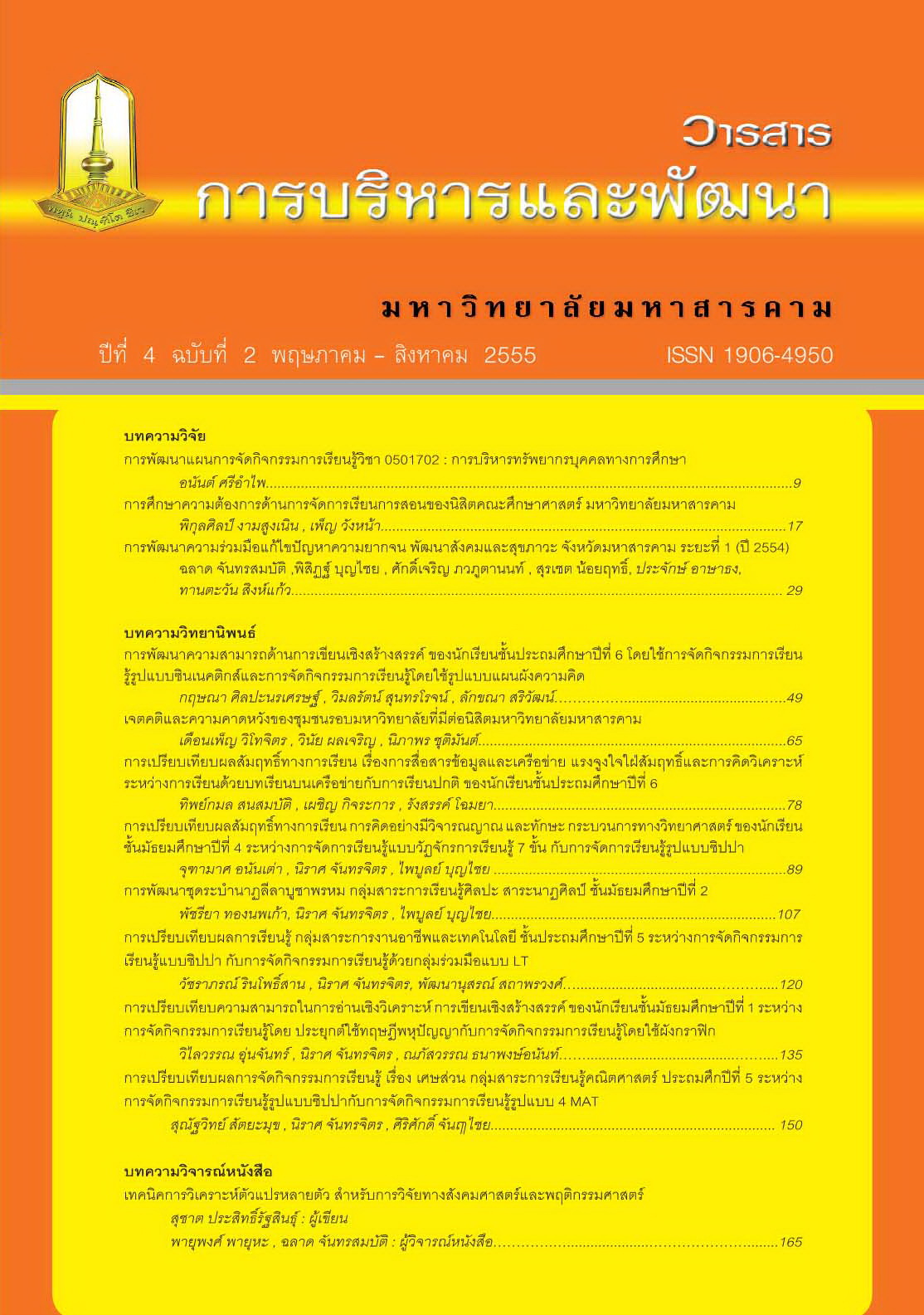การเปรียบเทียบผลสัมฤทธิ์ทางการเรียน เรื่องการสื่อสารข้อมูลและเครือข่ายแรงจูงใจใฝ่สัมฤทธิ์และการคิดวิเคราะห์ ระหว่างการเรียนด้วยบทเรียนบนเครือข่ายกับการเรียนปกติของนักเรียน ชั้นประถมศึกษาปีที่ 6
Main Article Content
Abstract
บทคํเดย่อ
การสอนโดยใช้บทเรียนบนเครีอข่าย เป็นวิธีการหนึ่งที่นำเอาศักยภาพของเทคโนโลยีอินเทอร์เน็ตมาใช้ในการพัฒนาการเรียนการสอนทำให้นักเรียนมีความสนใจในการเรียนมากยิ่งขึ้น สามารถเข้าเรียนได้โดยไม่จำกัดสถานที่และเวลาการวิจัยครั้งนี้จึงมีความมุ่งหมาย1)เพื่อพัฒนาบทเรียนบนเครือข่าย เรื่องการสื่อสารข้อมูลและเครือข่าย กลุ่มสาระการเรียนรู้การงานอาชีพและเทคโนโลยีชั้นประถมศึกษาปีที่ 6 ที่มีประสิทธิภาพตามเกณฑ์80/80 2) เพื่อหาดัชนีประสิทธิผลของบทเรียนบนเครือข่ายที่พัฒนาขึ้น 3) เพื่อเปรียบเทียบผลสัมฤทธิ์ทางการเรียนแรงจูงใจใฝ่สัมฤทธิ์ และการคิดวิเคราะห์ระหว่างนักเรืยนที่เรียนด้วยบทเรียนบนเครือข่ายกับนักเรืยนที่เรียนปกติ กลุ่ม ตัวอย่าง คือ นักเรียนชั้นประถมศึกษาปีที่ 6 ภาคเรียนที่ 1 ปีการศึกษา 2552 โรงเรียนอนุบาลร้อยเอ็ด อำเภอเมือง จังหวัดร้อยเอ็ด จาก 2 ห้องเรียน รวม 94 คนได้มาโดยการสุ่มกลุ่ม (Cluster Random Sampling) เครื่องมือที่ใช้ในการวิจัยมี 3 ชนิด ได้แก่ 1) บทเรียนบนเครือข่าย เรื่อง การสื่อสารข้อมูลและเครือข่าย 2) แบบทดสอบวัดผลสัมฤทธิ์ทางการเรียนซึ่งมีค่าอำนาจจำแนก ตั้งแต่ 0.25-0.81 ค่าความเชื่อมั่นเท่ากับ 0.92 3)แบบวัดแรงจูงใจใฝ่สัมฤทธิ์มีค่าอำนาจจำแนกตั้งแต่ 0.21-0.70 ค่าความเชื่อมั่นทั้งฉบับเท่ากับ 0.87 4) แบบวัดการคิดวิเคราะห์ที่มีค่าความยาก ตั้งแต่ 0.42-0.79 และค่าอำนาจจำแนก ตั้งแต่ 0.25-0.92 ค่าความเชื่อมั่นทั้งฉบับเท่ากับ 0.87 สถิติที่ใช้ ในการวิเคราะห์ข้อมูล คือ ร้อยละ ค่าเฉลี่ย ส่วนเบี่ยงเบนมาตรฐาน และการทดสอบสมมุติฐานใช้ t-test (Independent Samples) ผลการวิจัยปรากฏ ดังนี้
1. บทเรียนบนเครือข่าย เรื่อง การสื่อสารข้อมูลและเครือข่าย ชั้นประถมศึกษาปีที่ 6 มีประสิทธิภาพ เท่ากับ 83.07/81.86
2. บทเรียนบนเครือข่าย เรื่อง การสื่อสารข้อมูลและเครือข่าย มีค่าดัชนีประสิทธิผล เท่ากับ 0.6779
3. นักเรียนที่เรียนด้วยบทเรียนบนเครือข่ายมีผลสัมฤทธิ์ทางการเรียน และการคิดวิเคราะห์สูงกว่านักเรียนที่เรียนปกติ อย่างมีนัยสำคัญทางสถิติที่ระดับ .05 แต่นักเรียนทั้ง 2 กลุ่มมีแรงจูงใจ ใฝ่สัมฤทธิ์ไม่แตกต่างกัน
คำสำคัญ : ผลสัมฤทธิ์ทางการเรียน, แรงจูงใจใฝ่สัมฤทธิ์, การคิดวิเคราะห์, บทเรียนบนเครือข่าย, การเรียนปกติ
Abstract
Learning and instruction using web-based instruction is a method which implements potentials of Internet technology in development of learning and instruction. It can cause students to be more interested in learning. Also, they can learn without limitations of place and time. The purposes of this study were : 1) to develop web-based instruction entitled Data Communication and Network in the learning strand of career and technology for Prathomsuksa 6 with a required efficiency of 80/80, 2) to find out an effectiveness index of the developed web-based instruction, 3) to compare learning achievement, achievement motives and analytical thinking between the web-based instruction and learning through the traditional method. The sample consisted of 94 Prathomsuksa 6 students from 2 classrooms attending Anuban RoiEt School Amphoe Mueang, RoiEt Province in the first semester of the academic year 2009, obtained using the cluster random sampling technique. The instruments used in the study were 1) the web-based instruction entitled “Data Communication and Network”; 2) an achievement test with discriminating powers ranging 0.25-0.81, and a reliability of 0.92; 3) a motivation test with discriminating powers ranging 0.21-0.70, and a reliability of 0.87; and 4) an analytical thinking test with difficulties ranging 0.42-0.79, discriminating powers ranging 0.25-0.92, and a reliability of 0.87. The statistics used for analyzing data were percentage, mean, and standard deviation; and t-test (Independent samples) was employed for testing hypotheses. The results of the study were as follows :
1. The developed Web-Based instruction entitled “Data Communication and Network” for Prathomsuksa 6 had an efficiency of 83.12/81.86 which was higher than the established requirement.
2. The web-based Instruction entitled “Data Communication and Network” for Prathomsuksa 6 had an effectiveness index of 0.6779, showing that the students progressed their learning at 67.79 percent.
3. The students who learned using the web-based instruction showed higher learning achievement and analytical thinking than those who learned using the traditional instruction at the .05 level of significance. However they did not show achievement motives differently.
Keywords : learning achievement, achivement motives, analytical thinking, web-based instruction, traditional instruction

